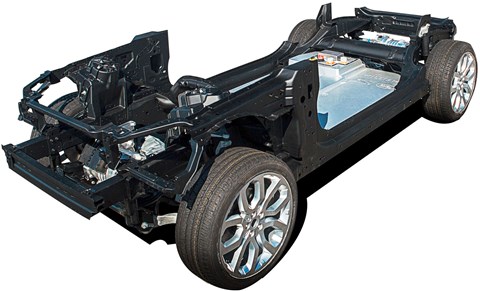► Jaguar readying an E-pace
► Taking the fight to Tesla
► Audi Q6 E-tron – watch out…
Think luxury Tesla rivals are solely a German pursuit? Think again: Jaguar is pushing ahead with a pure battery electric vehicle (BEV), and sources say it’ll be an SUV to take on the Model X and Audi’s Q6 E-tron.
Like every Jaguar including next year’s F-Pace, the BEV will be constructed of aluminium. While its hard points were carefully determined to meet US standards, the design is anything but boxy and boring. Instead, expect a low and flowing silhouette, a steeply raked windscreen and a tapered rear end, and a mix of F-Pace and C-X75 supercar cues to spectacular effect. A slippery shape, assisted by active and passive aerodynamic aids, is critical to conserve juice. Naturally the wheels will be big in diameter, but shod with relatively narrow rubber.
The propulsion system is still under wraps, though Jaguar recently showed an all-wheel-drive research chassis, featuring lithium-ion batteries housed in the middle, a 114bhp electric motor up front and 194bhp turning the rear axle. The company has signed a partnership with Magna Steyr, bagging capacity at its Graz plant in Austria. The BEV needs to find around 20,000 buyers a year to make money. As it’s slightly smaller than the F-Pace, the electric SUV could neatly be called E-Pace. Don’t expect sales until late this decade, however.
Jaguar Land Rover isn’t overlooking conventional powertrains, and work is underway on new inline six-cylinder engines to replace the V6. The four-cylinder Ingenium unit would provide the basis, a concept similar to BMW’s: it groups together 500cc cylinder packs to create its four, six and bent-eight engines.
Due in late 2017, JLR’s 3.0-litre six will feature direct-injection and turbocharging, and be offered in petrol and diesel form. The unit should be sufficiently versatile to produce 300/400/500bhp as a petrol, and 275/335/400bhp in diesel guise. Key benefits include lighter weight, reduced consumption/emissions and a natural fit for rear-wheel-drive Jaguars. That said, it’s equally well suited for the bigger Land Rover and Range Rover models.
Neatly, it provides a strong link to Jaguar’s impressive straight-six history, which took off with the XK120, won Le Mans with the C-type and D-type, and ceased production only as recently the 1990s. It’s all a far cry from the pure electric SUV of the E-Pace, but hey, that’s progress for you.

E-Pace chassis?
Jaguar unveiled this ‘electric drive module’, which it says could produce ‘twice the power and torque of any electric motor-generator in production today’
Flexible tech
The module can be inserted between any engine and transmission and would support every combination of electric drive – BEV, PHEV or MHEV (mild hybrid)